|
|
The Hofburg in the Centre of Vienna
During the visit of Vienna, viewing the Hofburg of Vienna as the former seat of government of the Habsburgs is really obligatory. But one should plan some time and have good nerves. Time because the Hofburg consists on several tracts, patios and plazas. The total of 18 tracts and 19 patios are not all released for viewing but each of te museums integrated in the Hofburg are definite a small or a bigger side trip worthwhile. The most famous should be the Sisi Museum with the Emperor's appartments and the Silver Chamber. By knowing the Sisi movies that are repeated any year for christmas, one is quickly disappointed considering the romantic picture that one got from the Empress. But one gets a realistic view to the political and personal circumstances of the Habsburg times. But one needs good nerves in order to cope with the touristical crowds of people that one always and anywhere comes across to and partly in narrow rooms. As we were there in autumn time during the low season and already had to cope with numerous visitors and we even had to wait sevweral times in the cafés for a free seat,the cirsumstances during the hig season are surely much more extreme. Something about the History of the HofburgToday, the Hofburg appears as a coherent and interwoven huge building komplex in which as a visitor one first has to get orientated. On the adjacent picture that can be enlarged by a mouse click, each of the wings are clearly visible at a glance. Since the year 1276, the originally rather small Hofburg was continuously expanded around a central point. Thus, those parts of the buildings one approaches from the exterior were originated at a later time. By this way, the Hoburg is clearly recognizable on the picture, the cladding is semicircular shaped and located at the front of the Heldenplatz (Plaza) that is arranged with meadows and the two horsemen monuments.This part was built as the last part between 1891-1913. 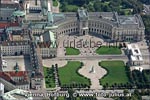
On the picture the path is also visible that comes from the right through the castle gate up to the centre of the original castle. The so-called inner ward marks a scholarship surrounded by building wings that was originally used for theatre performances and jousts. Upside, there also is the oldest central part of the Hofburg, the so-called Schweizerhof. 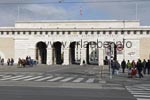
Today, it is possible to visit there the spititual and mundane treasury, a museum where crowns, sceptres and all kinds of power insignias of the church and dsynasty are exhibited. The exterior of the Schweizerhof the way we can see it today was originated approximately around the year 1552 by P. Ferrabosco, who could realize his arquitectural ideas at the time of the renaissance. Bit by bit, further buildings were originated around the inner ward. In front of the Schweizerhof, first the Amalien Castle was originated (1575-1588) and beside the St. Augustin Churhc of today (in the picture at the very right) the Stall Castle (1558-1563), which today accommodates the Spanish Riding School. Not before the building of the Leopold wing (1660-1668) and the Reich Chancellor wing, a coherent ensemble was originated with the conjunction of these buildings. Michael's Gate as the Gate of the "Old" HofburgApproaching the Hofburg from the centre, then, one first arrives at the Michaeler Plaza. Here ist the main gate to the "old" Hofburg, the Michael's Gate. The atmosphere at the Michaeler Plaza has, despite of the impressive cladding of the Hofburg, something municipally grown-up. One stands in front of the old St. Michael's Church, looks to the excavations of an originally stationed Roman camp, and has at the same time the possibility to go into a cosy café. At the beginning, this encounter of different historical epochs was a little confusing, as the arquitectural total image seems a little thrown together. 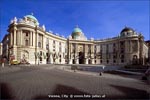
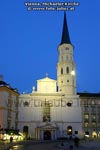
Therefore, the more liveliness this central place gets, specially because during the day, many tourists come here. Together with the Fiakern, this typical scenario results here for Vienna that is old meets new. Here is also the entrance to the famous Sisi-Museum, the Emperor's appartments and the Silver Chamber. These three museums can be visited individually or as a unit and take part in the way the Imperial family dined, lived and received their guests. If one is already there, a visit is surely worthwhile. Personal objects and the atmosphere of living and representation, in which the Imperial Family was at home, can be only seen otherwise in the Castle Schönbrunn. If one does not have enough time for an expanded viewing of Vienna, the concentrated viewing is also offered here in the city centre. 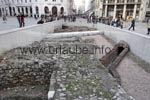
The Michaeler Plaza was originated with the realization of the Michaeler wing (1889 to 1893), that in former plans it was already supposed to communicate the Winter Riding School with the Reich Chancellor wing. By this way, also the Joseph Plaza was originated by a restructural measure that was accomplished between 1763 and 1769 under Nikolaus von Pacassi. He either communicated the court library and the St. Augustin Church with the Castle, so that for the Joseph Plaz, an almost closed but externaly unadorned area resulted. At this spot, one barely imagines that behind the cladding of the St. Augustin Church there is a quite large church or that behind the walls of the library there is one of the most beautiful pompous baroque rooms that highly fascinates and impresses the visitor. But before we view the pompous room we are first in the Sisi Museum and then in the treasury. Sisi Museum, Silver Chamber & Emperor AppartmentsIndeed, I was very amazed when I realized how many people wanted to visit the Sisi Museum just in the day I wanted to get there for the first time. In front of the Michael's Gertor tomen tried to handle the rush of visitors by trying to arrange them in sinuous lines side by side. I already expected a longer waiting time until one the men told me that this was rather an exception. Shortly before, several buses with Hungarian visitors arrived. Thus, I became confident and came one day later, and, behold, at least I could get straight away to the cash without any longer waiting time. Those who can afford it will need to go to the Sisi Museum during the biggest rush but wait for a more quiet time. 
But anyway, the inner part of the plaza is quite narrow also without crowds of people. As I was on my way with a rucksack, I repeatedely had to pay attention not to hit anywhere as the alleayways were very narrow. Zuerst First, one walks countless metres through the alleyways in which one has repeatedely the opprotinity to gaze at the dinnerware of the Habsburg times. This part is the so-called Silver Chamber. Not only materials as glass, porcelain or silver already appear as very special, it is much more the mass that buries one. It is really exciting to see the huge amounts of kitchen and cooking utensils that are still left from the Habsburg times, and with which big effort the coutly ceremony was inscened at the table. Unfortunately it was forbidden to make some pictures, otherwise the opprotunity would be given here to see pictures with countless variations of table decorations and glass cabinets with precious exhibits. Not until one walked through this part of the museum, one get to the Sisi Museum. This museum that was opened not earlier thn the year 2004 shows different facets of the Empress Sisi, a person that we almost experienced in a very soft version through the famous Sisi movies. In the real life of the Empress Sisi, who originally could grow up very vividly and close to the nature in Bavaria, the courtly ceremony apparently had some strong shady sides. In the original poems of Sisi and numerous personal objects of her everyday commodities, one gets an insight into her real life tht apparently was marked by melancholy and loneliness. Actually without a difference to our culture of today, due to her discontentment, the Empress turned to an increasingly blatant beauty and slimming craze that she celebrated with excessive sports. One soon gets conscious that deep inside, she could not have been a happy person. One also gets a small insight into the possible character of the Emperor Kaiser Franz Joseph by walking further through the Emperor's appartments. In the total of 1 office and residential rooms, one views the working, audience and sleeping rooms of the Emperor, whose catholic-military adamant discipline and structured daily routine started in the very early hours. Ceremonial Room: Part of the National Library of Today at the Joseph PlazaThe Austrian National Library actually consists on several reading roomsand individual museums which central is located in the new Castle at the Helden Plaza. Beside a museum for globes, papyrus or for example for handwritings and flyers, the ceremonial room should be the most impressive attraction. This is anyway the way I felt. I was simply buried by the size and monument of this room. 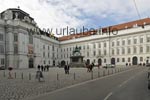
The shelves that rise almost 20 metres to the height and are stuffed with thick and partly very large books bound in leather almost covered the whole of the walls. The sight upwards went widely up to a cuppola ceiling masterly adorned by some frescos. The atmosphere was very light due to the ntural light incidence and the illuminated walls, thus it has nothing to do with an old and dusty library atmosphere. Just the opposite: there were some individual chairs on which one could unhurriedly let the eyes travel over this oversized room. 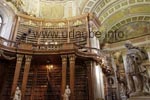
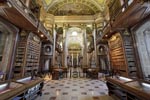
The entrance of the pompous hall is located at the Joseph Plaza right beside the St. Augustin Church. As from outside it is hard to imagine what is behind this cladding, the amazement after having entered the hall is the bigger. It is worthwhile in any case to visit this place. The history of the origination of this hall goes back up to the years 1723-1726. THe Emperor Karl VI. let the court arquitect of that time, Bernhard Fischer von Erlach and his son Sohn Joseph Emanuel, realize his court library. The baroque hall accommodates 200.000 books and today, it is of a reputation to be one of the most beautiful library rooms of the world. By walking unter the Michael's Gate, one gets into the inner court. In this low traffic area, only pedestrians and fiakers are allowed to circulate. Here, one has the opportunity to have a piece of cake in the café of the inner ward or to continue loafing under the eyes of the larger-than-life Emperor Franz I. At this point, we decide to visit the treasury. Mundane and Spiritual Treasury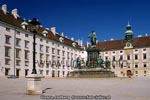
The entrance to the treasury is found by crossing the inner ward of the Hofburg that is adorned by a large monument of the Emperor Franz I. in a position of looking to the adjoining Swiss Gate. By walking through this gate one gets to the same named Schweizerhof. First, the mundane treasures are visible in the interior of the treasury. Here, one can see the symbols and insignias of the Austrin Empire (crowns, sceptres, ornates and glocus cruciger) as also of the holy Roman Empire (crown, lance, sword and pluviale). The history of the Order of the Golden Fleece is specially interesting that also divulges a part of his history with original objects, works of art and treasures. The geographical changings of the Austrian dominions can be followed at many wall panels. 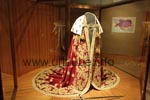
The visit of the treasure chamber in Vienna lets one take part on a more than thousand years old history of Europe. The mundane and churchy power are repeatedely pompously inscened, a thing that one can impressively relive by the insignias of maximum significance that are exhibited in the treasury chamber. With the robes, crowns, sceptres or ornaments, one can mentally take part on significant ceremonies of coronations or baptisms. Small altars, pictures of the madonna, golden crucifix and monstrances demonstrate the imposing prosperity of the eclesiastic property. As a matter of form, the treasures that belong to the Art Historical Museum of Vienna were subdivided from the 18th century in mondane and spiritual ones and were not located in the exhibition rooms of today until after the first world war. 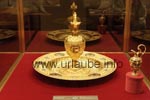
It is indeed allowed to take pictures in the interior of the treasury chamber, but without any flashlights. As the objects are individually illuminated in the glass cabinets, it is still possible to make good pictures due to the favorable light conditions. But from time to time, I had to wait a while until the cabinets were free, as the imposing robes of the Kings and Emperors were a very popular background for the pictures. By going from the interior of the Hofburg further in direction to the museum district , one soon stands right at the so-called Helden Plaza. If one does not know this plaza from pictures or from a tour on the Ringstraße, then an amazed'Wow'escapes involuntarily from one's mouth.. Helden Plaza and view to the new HofburgIt is approximately 100 years ago when, in the year 1918, the imperial monarchy ended and with this moment, also the glamour and glory of the Habsburg's house did. During a ramble through the centre of Vienna one still feels the imperial atmosphere that is determined by the arquitecture of the government buildings and museums ll around the Ringstraße. When we stood on the Helden Place, we were first a little battered by the pompousity and show-off of the many buildings. In a widely extended panorama view, one sees from here a gigantic coulisse. 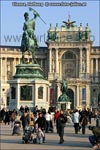
On one hand, the Hofburg is presented at this point with the new Hofburg as the youngest building part from its most representative side. On the other hand, the view is open to the parliament, city hall, Palace of Justice, Narural History Museum and the Historical Art Museum. It is hard to imagine that the whole arsenal around the Helden Plaza was originally planned as a much more feudal Emperor's forum. Both hoersemen monuments of archduke Karl and Prince Eugen gave the place its name that until the year 1821, it was named Parade Plaza. Still today it is easy to imagine with which emphasis history was inscened in front of this coulisse tht idealizes power and military strength. In this newer part of the Hofburg there are also some important museums accommodated. Beside the National Library there are different main focal points. In the museum of papyrus, one can gaze at the most different materials that were used as writing material in the course of the time: papyrus, pergament, wood, stones, bones - everything from the time between the 15th and 16th century AD. The Ephesos museum for example, it keeps archeological findings and sculptures that were found in the grounds of Vienna since the year 1895. Also the collection of old music instruments should be the most significant one of the times of the renaissance and the early baroque. Spanish Riding School in ViennaActually it could be said in Vienna, one sees enough horses and fiakers. But the Riding School of Vienna that is accommodated as Winter Riding School between the Michaeler Plaza and the Joseph Plaza, is surely something very special in a world wide level. Until now, we only knew the white horses that are artfully trained here from the TV. The so-called Lipizzaner are a very old European horse race which origin can be followed back up to the 16th century. This race was improved by the best Italian and Spanish stud horses of their kind. But they did not get their name of today until much later and since the 19th century, they were called Lipizza in relation to the slowenian village Lipica. The Spanish Riding School in Vienna is the only riding school of the world where it is trained in the classic style and in accordance to the equestrian circles. Thereby, the natural movements of the horse are so to say over-perfectioned and put in accordance with the horseman in a way that the maximum of harmony and aesthetics is achieved. Only the interior of the Spanish Riding School is already fascinating. The building of the winter riding school was caused by the Emperor Karl VI. between 1729 and 1735 by Josef Emanuel Fischer von Erlach. The long baroque hall completely arranged in white imposes by its numerous columns of the gallery, from which as a spectator, one can look into the hall that is illuminated by festive chandeliers. From the exterior, there is not much to see from a riding school, only a small building part of the Hofburg of Vienna. The interior of the Riding School can be visited either during the week at the daily training or on Saturdays/Sundays at the galas. As one can image, the entrance fee for the horse gala are steep of course. 
Copyright 2007-2008: Patrick Wagner, www.tourist-guide.biz |
||